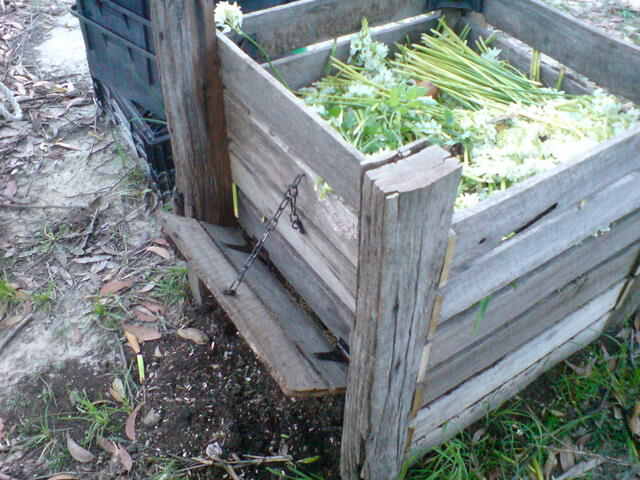Most gardeners envisage a compost heap as a hot steamy affair that breaks down within a matter of weeks leaving a rich brown organic material that can be dug into the soil to not only improve the soil’s nutrient levels but also help to increase its water and nutrient storage capacity. The reality, however, for the vast majority of gardeners is that their heap does not heat up and can sometimes become a slimy, stinking mess. The issue is to understand the difference between hot and cold composting.
Cold composting is a natural process that occurs in the layer of organic matter that forms on the soil surface in a natural forest environment. Various beneficial micro-organisms very gradually decompose the dead leaves, bark etc. When we bury or make small piles of organic waste in our gardens the same cool composting process occurs and is further enhanced by the activity of earthworms that are naturally attracted to feed on whatever organic matter they can find. From a gardener’s point of view cold composting is a very effective way of recycling organic materials to enrich their soil. There are a couple of situations, however, where cold composting is not ideal. Firstly where there are weeds or plant diseases present in the material to be composted. These problems will happily survive the cold composting and come back to haunt you. The easiest solution here is to either create a hot compost heap or put the offending material into a green waste bin where it will find its way into an industrial size compost heap at a local rubbish tip. Meat and other moist kitchen scraps can also create problems in cold compost heaps by creating a pile that is too moist and thereby becomes anaerobic (lacking in oxygen) and smells of byproducts like rotten egg gas (hydrogen sulphide). Again hot compost heaps and green waste bins are a solution. For kitchen scraps another very handy alternative is too simply bury them in a fallow soil bed where they will be broken down by earthworms.
Cold composting can also happen in heaps. I have a timber cold compost bin in operation with flaps at the base through which the finished cold compost is removed every few weeks while the top of the heap is replenished constantly with kitchen scraps, lawn clippings etc. The key to a cold compost bin is aeration which can be provided through gaps in the structure of the bin. Stirring up the top layers with a fork will also help to get extra air in. An even better tool to get down deeper for aeration is a Compost Mate, which is shaped like a giant corkscrew, pictured below. For a demonstration on how it works, check out Angus’s video>>>
Unlike a hot compost heap, a cold heap can be of any volume as it does not need to reach a critical mass to be a good environment for the particular micro-organisms that inhabit it. Cold composting can also be done in a dark dank corner of the garden behind a shed or whatever, making better use of garden space.
Hot composting occurs when several conditions are in place so that beneficial micro-organisms build up rapidly inside the heap and generate a lot of heat due to their high population levels and the resulting high rates of respiration occurring. Temperatures can build to as high as 75 degrees C. due to the action of thermophilic (heat loving) microbes. This is in direct contrast to the different suite of microbes that inhabit a cold compost heap. The high temps in a hot heap are enough to kill virtually any weed as well as plant pathogens such as black spot on rose leaves and this as well as the speed to completion are the great advantages of a hot heap. The conditions necessary for hot composting to occur are:
• critical mass – the heap needs to be at least a cubic metre in volume. Materials may need to be stockpiled to get sufficient volume together at once.
• an appropriate balance of nutrients- there needs to be sufficient nutrients in the heap to feed the micro-organisms. This can be provided by regular layers of manure or kitchen scraps alternating with dry high carbon materials such as dead leaves, shredded paper etc
• appropriate levels of oxygen – this can be provided by regularly turning the heap ie once a week with a pitch fork or special corkscrew action tool made for this job. A little trick is the use of a plastic PVC pipe drilled with lots of holes that is inserted into the heap to improve oxygen flow to the centre to lessen or eliminate the need for turning.
• Appropriate moisture levels – you should be just able to squeeze a few drops of moisture from a handful of the material from the heap. If there is more water the heap becomes anaerobic and favours ‘bad’ microbes, any less water and the growth of the ‘good’ aerobic microbes cannot continue at the levels needed for good heat build up.
• Layering the heap with alternate materials that are high in nutrients with layers such as shredded paper, corrugated cardboard, bark, dead leaves that are low in nutrients also gives a balance between nitrogen and carbon. Too much of either one leads to problems.
 For lots of information on home growing vegies, worm farming, composting and so much more, check out the book
For lots of information on home growing vegies, worm farming, composting and so much more, check out the book
“Grow Your Own – How To Be An Urban Farmer”


